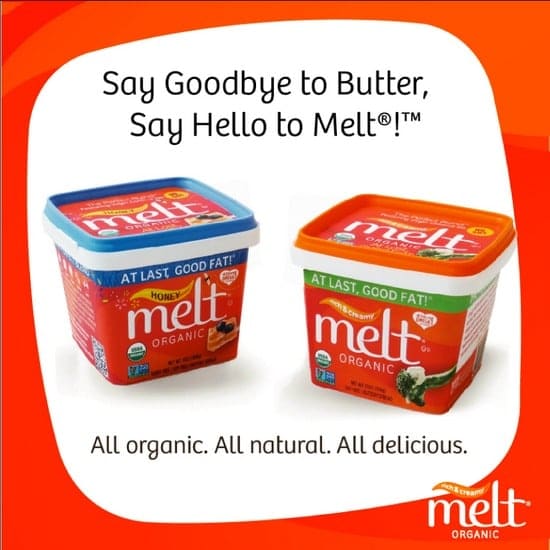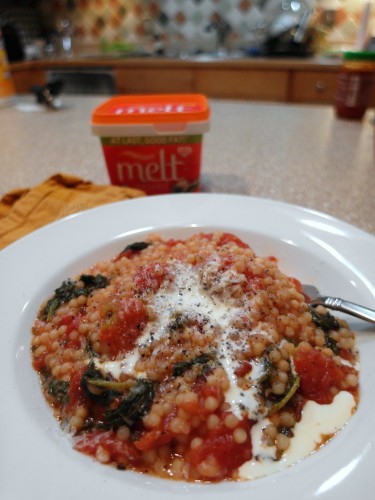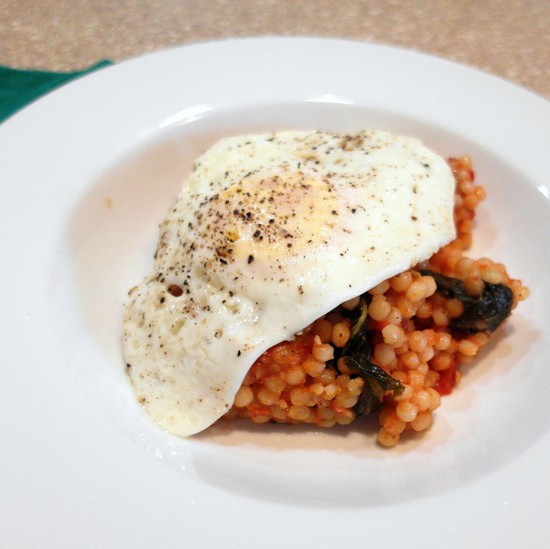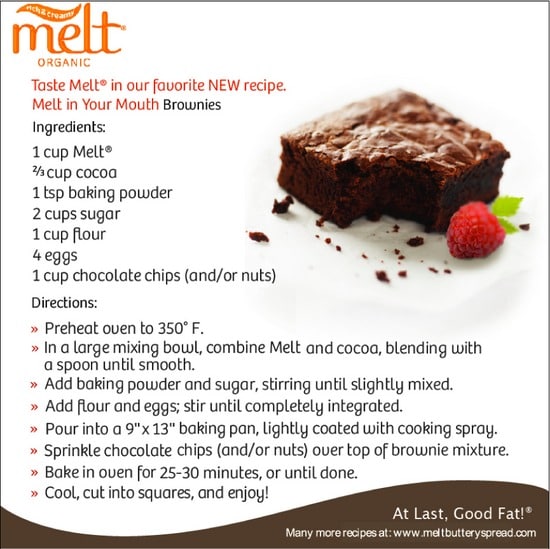This post is a Melt Organic Butter review. I very occasionally do product reviews, and I am leaving this review of Melt spread on the site, because people keep searching for this information.
I hope you find this review helpful. NOTE: The original publish date for this review was 2013. Since I wrote this, Melt has expanded its line of plant-based butter substitutes to include sticks as well as tubs.
Disclosure: I was compensated to write this post. The Melt Folks sent me coupons to try Melt Organic Buttery Spread on them. They also sent me a wee spreader and a thin, flexible cutting board. Thanks, Melt folks. Any text in block quotes comes from the folks at Prosperity Organics (Melt Makers). Photos, unless otherwise noted, are from Prosperity Organics.

What Fats I Usually Use
I like butter. Love it, even. And I am also a huge fan of coconut oil. When I saute, I generally use a mixture of the two, the butter for flavor and the coconut oil for its relatively high smoke point and its health benefits.
When the Melt folks emailed me awhile back, asking if I’d like to give their product a whirl, I have to admit I was a bit dubious. I emailed them back and told them as much, but I also said I’d be willing to try Melt and see what I could do with it. They agreed and sent me my coupons which I used and a spreader and flexible cutting board, neither of which I have used at this point.
Pastry Chef Online Participates in Affiliate Programs. If you make a purchase through one of my links, I may earn a small commission. For more information click to read my disclosure policy
I couldn’t find Melt Organic Buttery Spread at either Kroger, Harris-Teeter or Lowe’s Foods here, so I pilgrimaged to Whole Foods to pick some up.
Currently, Melt comes in Original and Honey flavors, and I believe a chocolate version is set to come out in 2014. I intended to pick up the two available flavors, but all my Whole Foods carried was the Original, so Original it was.
Melt Products, 2021
As of now, May of 2021, Melt makes the following organic plant-based buttery spreads:
- Melt Organic Probiotic Butter Made from Plants in a 10 oz tub
- Melt Organic Butter Made from Plants in a 13 oz tub
- Melt Organic Salted Butter Sticks Made from Plants with 4 4oz sticks, or the way conventional butter is sold
- Melt Organic Unsalted Butter Sticks Made from Plants with 4 4oz sticks the way “cow butter” is sold
When I got my Melt home, I checked out the ingredient list:
- Organic Oil Blend (Organic Virgin Coconut Oil, Organic Palm Fruit Oil, Organic Canola Oil, Organic Hi-Oleic Sunflower Oil, Organic Flaxseed Oil)
- Water
- Organic Unsalted Butter
- Sea Salt
- Organic Butter Flavor
- Non-GMO Sunflower Lecithin
- Tocopherols
Note that the original formulation of Melt included butter, so it was not vegan.
As the ingredient list currently states, and as their label states, Melt is now a plant-based butter substitute and contains no actual butter.
Melt Ingredients (2021)
- Expeller-Pressed Organic Oil Blend (virgin coconut oil*, palm fruit oil, canola oil, high-oleic sunflower oil, flaxseed oil)
- Water
- Sea Salt
- Organic-Compliant Natural Flavor
- Tocopherols
- Sunflower Lecithin
- Organic Annatto
*Fair for Life Fair Trade certified ingredient at least 20% fair trade content.
More About Melt’s Oil Blend, from the Melt Website
INGREDIENTS FROM A HIGHER SOURCE
Melt Organic’s clean label products has been carefully chosen and combined into the perfect blend so the benefits of each organic oil are enhanced. Melt Organic is free from gluten, soy and nuts.
Organic Coconut Oil
Organic coconut oil is a good, saturated fat that keeps undesirable (LDL) cholesterol down. Research has shown that organic coconut oil can boost metabolism, increase thyroid activity, promote weight loss, and provide optimal nutrient absorption. Plus, coconut oil has a similar melt point to butter, making it ideal for baking and cooking.
Organic Flaxseed Oil
Organic flaxseed oil is one of the best sources of Omega‐3s available. Clinical research has linked life‐threatening diseases such as obesity, some cancers, heart disease, and diabetes type II with a chronic deficiency of dietary Omega‐3 essential fatty acids. Flaxseed oil has the highest plant-based concentration of Omega‐3 and can reverse deficiencies common in the American diet.
Organic Palm Fruit Oil
Produced from the fruit of the palm, palm fruit oil contains very high amounts of carotenoids, the antioxidants our bodies convert to Vitamin A. Vitamin A may also provide protection from free-radical damage that some studies have linked to cancer. It is odorless and tasteless, perfect for baking and cooking. Our palm fruit oil is certified Eco-Social and Fair Trade by the Roundtable on Sustainable Palm Oil (RSPO) to ensure that it is produced both ethically and ecologically.
Organic Canola Oil
Canola oil, made from the crushed seeds of the canola plant, is a non-GMO variety of rapeseed. It is an excellent source of monounsaturated fats in the form of Oleic Acid and Omega-3 fatty acid, and Alpha-Linoleic Acid. Studies show that ALA may help protect the heart through its effect on blood pressure, cholesterol, and inflammation. We only use organic canola oil that is expeller-pressed (hexane-free), and tested for GMOs and rancidity in every batch.
Organic Hi-Oleic Sunflower Oil
Organic hi-oleic sunflower oil is composed almost exclusively of monounsaturated fat (86%), with small amounts of saturated fat (10%), and polyunsaturated fat (4%). Hi-oleic oils have enhanced fatty acid profiles making them higher in monounsaturated fats and lower in polyunsaturated fats. Hi-oleic sunflower oil is also a source of Vitamin E. Melt Website
How Does It Taste?
As soon as I finished reading the ingredient list, I reached for a spoon. I don’t like to waste time.
Melt tastes rather pleasantly of both coconut oil and butter, although the finish is a bit thin. It doesn’t have the depth that either coconut oil or butter have by themselves, but still, I would call it pleasant and clean and certainly more tasty than the margarine I have tasted.
Do you know how coconut oil has a bit of texture to it? Well, Melt has that. It almost seems a bit grainy from the coconut oil, although that graininess goes away once it melts onto your tongue. The texture isn’t off-putting, but I just wanted to note it so you’d know.
Does It Spread Like Butter?
Melt Organic Buttery Spread is more or less like any spreadable margarine, consistency-wise.
Since coconut oil and ghee (in the 2014 iteration. Melt is now 100% vegan) are both pretty much rock hard at refrigerator temperatures, I would guess it gets its spread from the other mixture of oils, some of which I assume remain liquid when cold.
As well, water is the second ingredient listed after the “Organic Oil Blend,” and I’d bet the high water content has a lot to do with its spreadability straight from the fridge.
How Does Melt Behave When Heated?
When I melted some Melt (ha!) in a pan, it remained the same color as it did when solid.
Would you like to save this post?
That was kind of odd for me–I expect most fats to melt into a translucent (if not transparent) liquid. But the Melt remained opaque.
Eventually, it started to act like “regular fats,” and I would guess that happened when the water cooked off.
Since it does seem to have a relatively high water content, when melted, Melt first behaves like a water-type liquid and then eventually as a fat.
It is so “wet” when first melted that I didn’t even want to spread it on toast.
I had the feeling that the toast would just end up wet and not buttered. So, even though Science sighed, I passed on using it to butter toast.
I also knew that I wouldn’t really be able to bake with it since I didn’t know the water content and wouldn’t be able to substitute for that without a lot of futzing about. (UPDATE: Now that Melt produces “butter from plants” sticks, it is a viable baking ingredient that should not change the texture of your batter).
Melt: What I Cooked with It
As I write this review, my wee cube of Melt (13 oz) is almost gone.
I have used it to fry eggs, to cook rice and rice pilaf, in scrambled eggs, to make a lovely Israeli couscous dish with kale in it, and… Let’s see. I didn’t write down everything I did, but I pretty much used it for everything that I would have normally used butter and/or coconut oil and even olive oil in.

How It Works As a Fat to Cook With
Overall, Melt performed well.
Again, once the water cooked off, it behaved pretty much like any regular fat.
It kept my eggs from sticking, it lent a bit of a buttery/coconutty/creamy edge to almost everything I made with it.
Foods browned as expected (again, once the water cooked off), and I felt good about using rather copious amounts of it since it has a 2:1 ratio of Omega 6 to Omega 3 fatty acids (per the label), it contains healthy fats, and is organic, fair trade and non-GMO to boot.

Would I Buy Melt for Myself?
I have wrestled with this question for awhile.
I have to say that I will most likely stick with my organic butter (and grass-fed when I can find it and/or feel like splurging) and my big vat of virgin coconut oil from the Costco.
The main reason is that I can use butter and coconut oil in my baking, and I don’t think I can use Melt that way because of what seems to me to be a very high water content. (UPDATE: Sticks are now available, making it a viable baking fat).
Now that I know sticks are around, I might use it to make my vegan chocolate Christmas cake. And if I had vegan friends coming over for brunch, I’d absolutely use Melt for frying up these vegan hashbrowns.
Although here’s a brownie recipe made using the original tub formulation.
As you may notice in the photo of the couscous dish, the melted Melt is weirdly opaque (I told you), and I think that has a lot to do with how the water and fat are emulsified.
They must remain in a fairly stable emulsion at pretty high temperatures.
Even though I think I’ve figured out why it remains the same color when melted, I find it aesthetically off-putting, most likely because I’m used to the more translucent/transparent way that butter melts down over a stack of pancakes (or whatever Warm Thing you put it on).
Now I’ve given you two reasons why I would most likely stick with the fats that I’m already using.

Melt Vs. Earth Balance
I guess Melt’s most direct competition is Earth Balance Buttery Spread. It costs less than Melt ($3.99 for 15 oz, 2014 price) and is non-dairy so it’s suitable for vegan cooking.
If you’re not vegan and you like the taste of butter, Melt is the way to go, if the choice is between the two. Since Melt actually contains butter (or ghee, not to mention the Mysterious Butter Flavor) it actually does have an authentic-if-mild butteryness.
UPDATE 2021: Now Melt DOES NOT CONTAIN BUTTER, so it is 100% vegan.
How Does Melt Stand Up, Price-Wise?
I will say that for being fair trade, organic and non-GMO certified, Melt Organic Buttery Spread is a cost effective alternative to organic butter and virgin coconut oil. According to Wegman’s (all pricing is from the Fredericksburg, VA store and from 2014), a 13 oz container of Melt (original) costs $4.99 or about $0.38/ounce.
A 16 oz jar of Spectrum Unrefined Coconut Oil costs $9.49, or about $0.59 per ounce. A one-pound carton of Wegman’s brand Organic Butter costs $3.99. That translates to roughly $0.25/ounce.
If you wanted to use half coconut oil and half butter for cooking, you’ll spend an average of $0.42 for that mix.
Using Melt will save you 4 cents an ounce. That might not sound like a lot, but when budgeting, sometimes every penny counts!
The Bottom Line
Even though I probably wouldn’t purchase it doesn’t mean that I don’t think it’s a pretty good product. There are just some products that I am already using that I love and work beautifully for me in my baking, so I find no need personally to start baking with Melt.
Melt is certainly not margarine; it’s not butter; it’s not coconut oil. It’s a product that stands alone, so you can save a bunch of time in just picking up a container or two of Melt as opposed to comparison shopping for butter or coconut oil. And you can just leave the margarine right there on the shelf.
Thanks, Melt folks, for caring enough about our health, the environment, and our pocketbooks, to come out with a product that folks can feel good about using.
Although I wasn’t over-the-moon in love with Melt, I did like it. I tried to be as fair as I could so you’ll know what to expect. And if you get no other take-away from this post, know that I will always give my honest opinion about any product I encounter, coupons or not.
Have you guys tried Melt Organic Buttery Spread? What did you think? Would you be more likely or less likely to give it a try after reading this review?
Thanks so much for reading and for your comments, and I hope you have a wonderful day.



Join in Today!
I tried using the buttery sticks in a standard brownie recipe as a 1:1 replacement for butter/margarine, and it came out as an oily mess that never hardened. I then tried reducing the Melt in half, but it still came out as an oily mess. I was also using Just (vegan egg substitute) – but it seems like Just works fine as an egg substitute in other receipes. Now I’m reluctant to use Melt buttery sticks in a cookie recipe.
Thanks for weighing in on the Melt. I would have to try it with it as the only substitution in a recipe to make sure it’s really the Melt that’s the issue. But yes, that does give me pause.
Melt customer support replied to me quickly and said, “Unlike dairy butter, our plant-based butter contains a higher proportion of water. We have spoken to a local co-op that uses our butter in their cookies and they mentioned the trick is keeping the butter cold before mixing it in the batter. Yes, our baking sticks made from plants can be used in recipes as a 1:1 substitute. From your oily description, it sounds like the oils began to separate which happens when the butter sits out and reaches a temperature of above 53 degrees Fahrenheit. ”
So now I know not to melt the Melt buttery sticks in any recipe.
I’m glad they got back to you so quickly! And thanks for letting me know. I will add this info to my post.
I love the flavor of Melt! I always have it in the fridge.
I recently started on the Mediterranean diet, and they recommend using “Ghee”.
I did buy a jar to try, but I still have my Melt. Ghee is expensive! Do you know if Melt is equivalent to Ghee?
Is one better than the other?
Hey, Mary! Yes, I think Melt tastes pretty good too. Ghee is definitely a great ingredient, and it is nothing more than 100% butterfat as opposed to whole butter which is butterfat, milk solids, and some water. It is very similar to clarified butter except the milk solids are allowed to start turning color before straining. There are supposedly a lot of health benefits from using ghee, and I use it pretty regularly. If you have access to an Indian grocery, it’s much more reasonably priced there than at a “regular” grocery store. Melt doesn’t contain any butterfat at all. The ingredients are (and I’m copying this from a website): Expeller-Pressed Organic Oil Blend (virgin coconut oil*, palm fruit oil, canola oil, high-oleic sunflower oil, flaxseed oil), Water, Sea Salt, Organic-Compliant Natural Flavor, Tocopherols, Sunflower Lecithin, Organic Annatto. Nothing is inherently “wrong” with any of these ingredients, but ghee is a more “pure” product because it just contains 1 ingredient.
I often stretch my ghee by mixing it half and half with coconut oil or olive oil. You may want to try that and see how you like it. It’s also excellent melted and poured over popcorn! 🙂
Awesome!
Thanks!
You’re welcome. Any time!
I like it a lot. Its different. I was looking for something healthier than butter and margarine. I like that it has the omega threes!
Yes, it’s great to have those healthier fats, Carole, and it’s always great to find alternatives!
I use MELT and really enjoy its taste and grainy texture. I’ve used it to sautee, put on bread, and add to grains for taste.
So glad you enjoy using it, Julie! Thanks for stopping by!
I just bought this to bake for my daughter who must avoid all dairy. The ingredients say nothing about ghee or butter flavor. Do you know if they have changed the recipe?
Hi, Mary Grace. I wrote this a couple of years ago, and it seems that they have changed it to make it vegan. Here is their FAQ page for you to doublecheck. http://www.meltorganic.com/our-products/faqs/
I love Melt. Have been using it for a long time. It is healthy and delicious!
I just tried the original in a grilled cheese sandwich; it worked just fine, bread got nice and toasty, but my first thought was, “this tastes like coconut oil, not butter at all”. I bought it b/c it was cheaper than grass-fed butter and sounded like it would be good for me. I won’t buy it again, even though I do like that it is spreadable out of the fridge.
Thanks for your feedback; hopefully others will read it and learn from it. Especially if they don’t like the flavor of coconut oil. For me, it’s definitely a mix of the two, but personally, I’ll just be using either straight coconut oil or grass-fed butter. 🙂
I love it! I have to give up soy and milk proteins for my infant’s allergy that ends up I my breast milk. While I always prefer butter, this is a great soy/dairy free option. I also called Melt today and they indicated they are getting rid of the Ghee ingredient. Love that I had an option.
I’m glad there is a viable option out there for you, Molly! Interesting about the ghee. I wonder if they will have to change the name since it will no longer contain any butter-type ingredient at all. Hmmm… 🙂
Don’t think I would try it for a couple of reasons. I live in a rural town and if you had trouble finding it, I probably wouldn’t be able to find it at all. I am a purist when it comes to butter. There is nothing else with the flavor, textutre and melting ablities as butter. So I say no thank you. Coconut oil is OK but olive oil is my go to when butter won’t do.
I get it, Trish! I think it might be a great fit for some folks, but it will never be my go-to either. Still, I do like that they have taken care to keep it GMO-free, Organic, etc, which is more than can be said of “regular” grocery store butter. =)
Great review Jenni. I think the main problem is that you (nor I, for that matter) are not the target market for this product. I’m thinking that, as you said, someone who is currently using Earth’s Balance or something similar is who is most likely to try it. I’m strictly a butter – and more recently coconut oil – user. I guess I’m happy with the saturated fat levels in butter LOL. I feel like nothing can replace that taste and texture of butter.
I’m with you–there is nothing like butter! =)
I have not yet tried Melt, as I have not seen it. I can say, based on your review, that if it’s counterpart is Earth Balance and it tastes better, I’d try it. None of us cared for EB. We went back to butter. I’ve never thought to combine butter and coconut oil, I’ll have to try it.
Oh, great! I’m glad you found the review helpful! I believe they have a store locator on their melt website that will let you know where you can find it in your area, Jennifer. 🙂